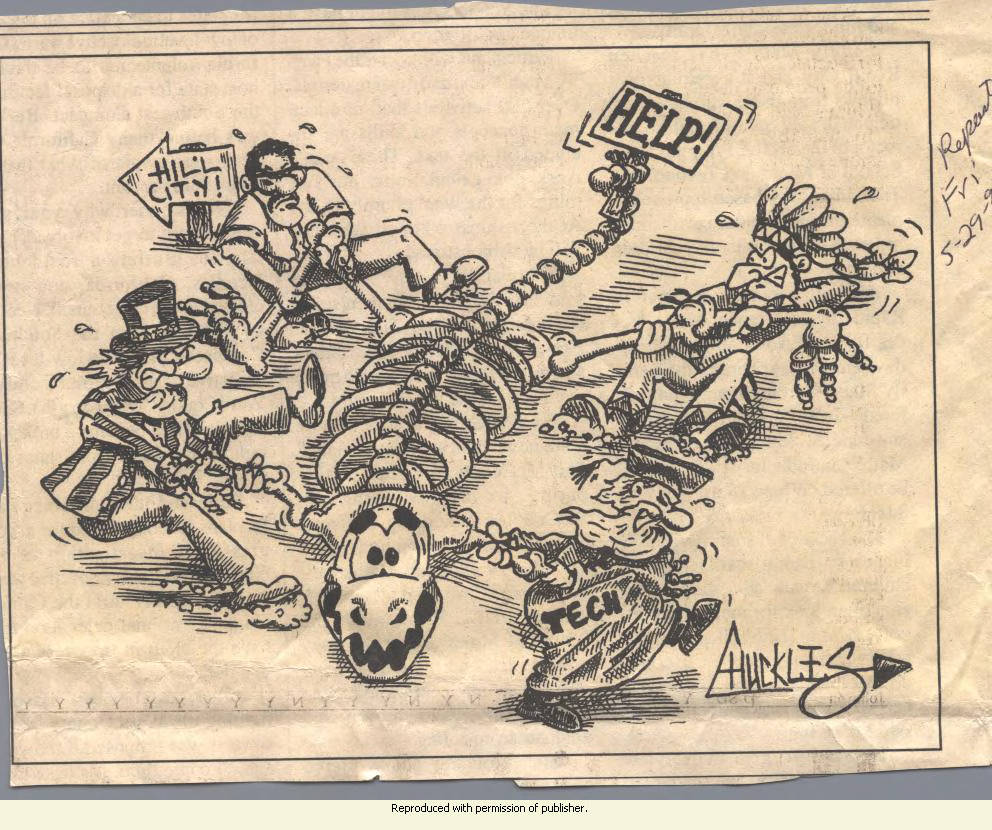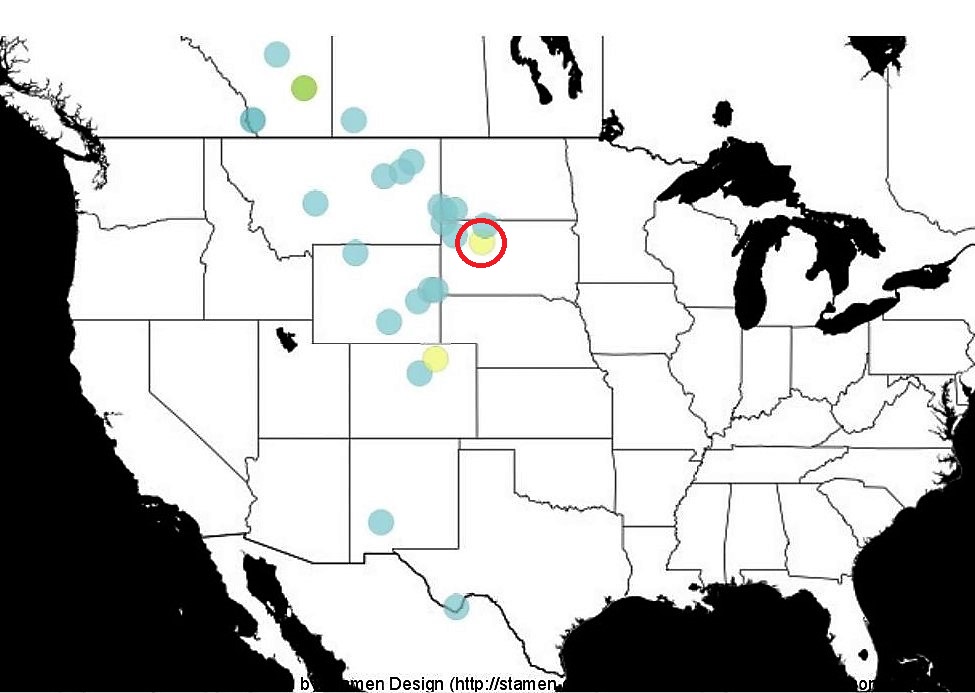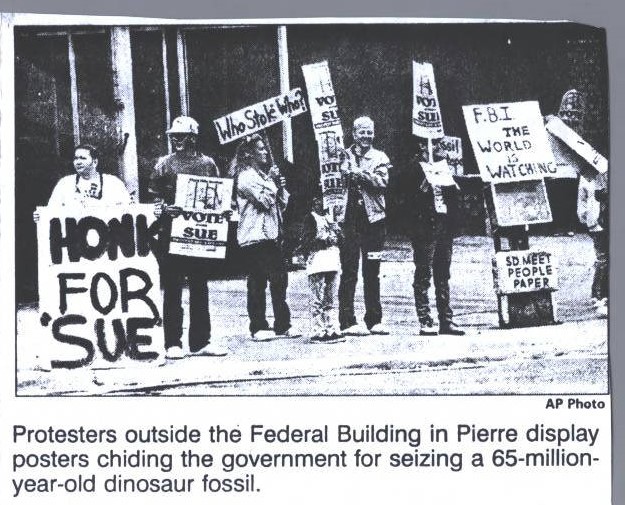Sue: Fighting over Bones and Land
by Alexander Bräuer, 03/12/2016.
Summary
In 1990, Susan “Sue” Hendrickson, a worker of the Black Hills Institute, discovered a fossil in the Cheyenne River Indian Reservation in western South Dakota. The bones were found on the land of Maurice Williams, a member of the local Sioux Tribe. The Black Hills Institute, led by Peter Larson, paid 5,000 US dollars for the fossil to Maurice Williams and excavated a Tyrannosaurus rex that became known under the name of its discoverer, “Sue.” The size of the fossil and its condition (nearly 85 per cent of the bones were preserved and found) constituted a unique find and made Sue a valuable object on the fossil market. In 1997, the fossil would be auctioned for 8.36 million US dollars. In this article I will focus on the legal battles around the ownership of the bones between the excavation in 1990 and the auction in 1997, and try to show how constructions of an American antiquity can be shaped by postcolonial discourses. These battles involved different parties like the private Black Hills Institute, the Federal Government, and the Sioux tribe or the land owner Maurice Williams. The process was highlighted by spectacular events such as the seizing of the bones by the FBI and the National Guard from the Black Hills Institute in 1992. Furthermore, the national media followed the process closely and a public debate about the ownership rights to the fossil and the right to excavate them was running simultaneously.
The Participants
Five main parties were involved in the legal conflict. The Black Hills Institute (1) discovered and unearthed the fossil and was founded 1974 in Hill City, South Dakota as a private corporation for the excavation of fossils and their preparation. Peter Larson, the founder and president of the Institute, is a well-known paleontologist who had received some criticism for his business of selling fossils. The Institute received permission to unearth the fossil from Maurice Williams (2), the landowner. Williams, a member of the Cheyenne River tribe, owned land in the Cheyenne River Indian Reservation, the fourth largest Indian reservation in the United States. The Cheyenne River Sioux Tribe (3) holds sovereignty over the Cheyenne River Indian Reservation and wanted to establish its rights and rules over fossils found on their land. The Federal Government (4), on the other hand, wanted to strengthen its own right to land-ownership and ideally secure the bones for the public and scientific interests. Furthermore, the South Dakota School of Mines and Technology (5) plays a minor role as the representative of the scientific community affiliated with public institutions. The university served as the storage place for the fossil after the seizure from the Black Hills Institute and is therefore perceived to be aligned with the federal government.
The Timeline
The ranch of Maurice Williams is located on land held in trust by the United States for Williams’s ‘benefit’. The relationship between (individual) Native American land owners and the federal government was premised on the General Allotment (Dawes) Act of 1887, which divided tribal lands into small allotments in order to privatize land ownership. After the discovery of the fossil and the excavation, the Black Hills Institute issued a 5,000 US dollar check to Williams, allegedly for the title to the fossil and the right to excavate it. Neither a federal agency nor the tribal officials were informed about the deal and the excavation. The bones were removed to the Black Hills Institute in Hill City for restoration. The FBI and National Guard raided the Institute in May 1992 and seized the fossil based on the Antiquities Act of 1906. In the following years the Institute sued the government in various ways for the ownership of the fossil whereas the Cheyenne River Indian tribe also claimed interest in the fossil on the basis of preserving the tribe’s cultural heritage. The District Court rejected the lawsuit of the Institute because the United States Department of the Interior had to give a permission for the sale of tribal land. Fossils were seen to constitute a portion of the land. The ruling was upheld in an appeal in December 1993 and following appeals were turned down. The Supreme Court finalized the dispute in 1994.
Remarkable in the various Court proceedings are two central aspects. First, the government succeeded in its right to assume stewardship for Native American landowners and consequently, self-government by the tribes was denied. Second, the courts ignored the Native American perspective on land, soil, and fossils.[1] Instead, the judges chose to consult a definition by the State of South Dakota that saw land as solid material of the earth no matter what ingredients it contains. The facts that Sue was once a living animal or that Native Americans had their own ideas about land and fossils were ignored.
The Media
Many court rulings are influenced and probably even decided by the public opinion. At the same time verdicts are interpreted and can be shaped in the aftermath through the media. In the following two paragraphs, this article will take a closer look at two selected representations of the dispute: the coverage by local newspapers in South Dakota during the course of the conflict and the release of a movie about Sue in 2014. The dispute over Sue was widely covered in the local newspapers of South Dakota, especially between 1992 and 1994 when the decision still was very much in the open. Some significant aspects of this coverage stood out. For instance, Maurice Williams is often characterized as a rancher who got what he deserved with the 5,000-dollar payment. In this context the real value of the bones is not mentioned. Instead the given information is that 5,000 dollars was the highest sum ever paid for a fossil. The Cheyenne River Sioux Tribe is hardly mentioned and their sovereignty over their lands or their view on fossils played no role at all. Local newspapers sympathized largely with the Black Hills Institute. Like most people in rural South Dakota, they saw the FBI and the government in Washington as enemies and were not shy to show their support for a local business bringing much needed employment into the area.
The documentary Dinosaur 13 (2014), based on Larson’s book about Sue, shows how persistent the settler-colonial figure of the heroic explorer is in American culture. It is an ode on commercial collectors that never even acknowledged a Native American point of view on fossils. Instead it tries to establish the discovery and excavation as the crucial indicators for the ownership and thereby favors the Black Hills Institute. Furthermore, and fitting into contemporary criticism of big government, the federal government is attacked for the seizure of the fossil. And, last but not least, private fossil trade corporations are depicted as the ‘real’ scientists because of their ‘superior’ experience in field work – in contrast to scientists in public institutions who prefer to stay in universities and museums. For these rather popular discourses, the documentary won an Emmy Award and was nominated for the Grand Jury Price of the Sundance Festival.
Overall, the Black Hills Institute could provide the best story around the discovery of Sue – including ‘heroes’ like Susan Hendrickson and Peter Larson – and therefore dominates the media representation until today. The battle over the bones of Sue illustrates two important points for the construction of an American antiquity. First, these conflicts on the ground are often messy with no clear-cut border between the involved parties. Second, and even more important, Native American perspectives on land and fossils are not ruled against in court, but they are ignored or not acknowledged as such. This ignorance – manifested in a state with a significant indigenous population – is transferred to the media representation of such conflicts.
NOTES
[1] Bradley, Lawrence W. Dinosaurs And Indians: Paleontology Resource Dispossession From Sioux Lands. Outskirts Press, 2014, p. 2.
FURTHER READING
Bradley, Lawrence W. Dinosaurs And Indians: Paleontology Resource Dispossession From Sioux Lands. Outskirts Press, 2014.
Dussias, Allison M. “Science, Sovereignty, and the Sacred Text: Paleontological Resource and Native American Rights.” Maryland Law Review 55:1 (1996), p. 84-159.
ILLUSTRATIONS
Figure 1: Cartoon about Sue ownership in a local newspaper. Source: Rapid City Journal, 05/29/1992.
Figure 2: Bones of Tyrannosaurus Rex found in North America. The archeological site of Sue is highlighted with a red circle. Source: https://paleobiodb.org; accessed 03/12/2016.
Figure 3: Photograph from a local newspaper. Source: Rapid City Journal, 06/16/1992.



